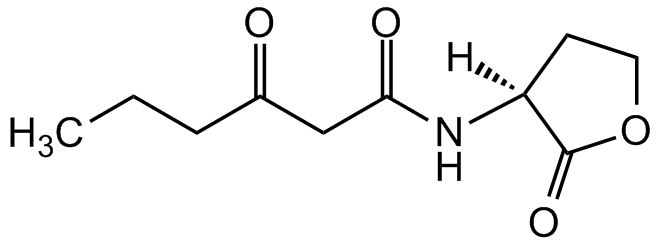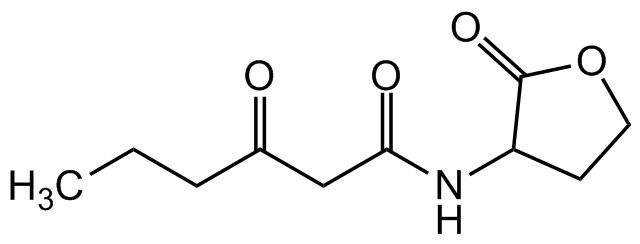
Chemical Structure
N-(3-Oxohexanoyl)-L-homoserine lactone
CDX-O0057
CAS Number143537-62-6
Product group Chemicals
Estimated Purity>97%
Molecular Weight213.2
Overview
- SupplierChemodex
- Product NameN-(3-Oxohexanoyl)-L-homoserine lactone [143537-62-6]
- Delivery Days Customer10
- CAS Number143537-62-6
- CertificationResearch Use Only
- Estimated Purity>97%
- Molecular FormulaC10H15NO4
- Molecular Weight213.2
- Scientific DescriptionChemical. CAS: 143537-62-6. Formula: C10H15NO4. MW: 213.2. Synthetic. N-(3-Oxohexanoyl)-L-homoserine lactone is a small diffusible signaling molecule and is a member of N-acyl-homoserine lactone family. N-acylhomoserine lactones (AHL) are involved in quorum sensing, controlling gene expression, and cellular metabolism. The diverse applications of this kind of molecule include regulation of virulence in general, infection prevention, and formation of biofilms. At increased populations of bacteria, localized higher concentrations of 3OC6-HSL, an endogenous ligand to transcriptional factor LuxR, leads to increased production of both the AHL synthase and proteins responsible for bioluminescence. Numerous other species of bacteria also employ 3OC6-HSL in cell-to-cell communication. An autoinducer of P. fischeri luciferase and a specfic genetic regulator that is unrelated to at least one of the enzyme systems that it induces. It acts after excretion and accumulation in the extracellular medium. - N-(3-Oxohexanoyl)-L-homoserine lactone is a small diffusible signaling molecule and is a member of N-acyl-homoserine lactone family. N-acylhomoserine lactones (AHL) are involved in quorum sensing, controlling gene expression, and cellular metabolism. The diverse applications of this kind of molecule include regulation of virulence in general, infection prevention, and formation of biofilms. At increased populations of bacteria, localized higher concentrations of 3OC6-HSL, an endogenous ligand to transcriptional factor LuxR, leads to increased production of both the AHL synthase and proteins responsible for bioluminescence. Numerous other species of bacteria also employ 3OC6-HSL in cell-to-cell communication. An autoinducer of P. fischeri luciferase and a specfic genetic regulator that is unrelated to at least one of the enzyme systems that it induces. It acts after excretion and accumulation in the extracellular medium.
- SMILES[H][C@@]1(CCOC1=O)NC(=O)CC(=O)CCC
- Storage Instruction-20°C,2°C to 8°C
- UNSPSC12352200

![N-(beta-Ketocaproyl)-L-hoMoserine lactone [143537-62-6]](https://www.targetmol.com/group3/M00/03/27/CgoaEGY7SGyEb8O0AAAAADpGysE699.png)
